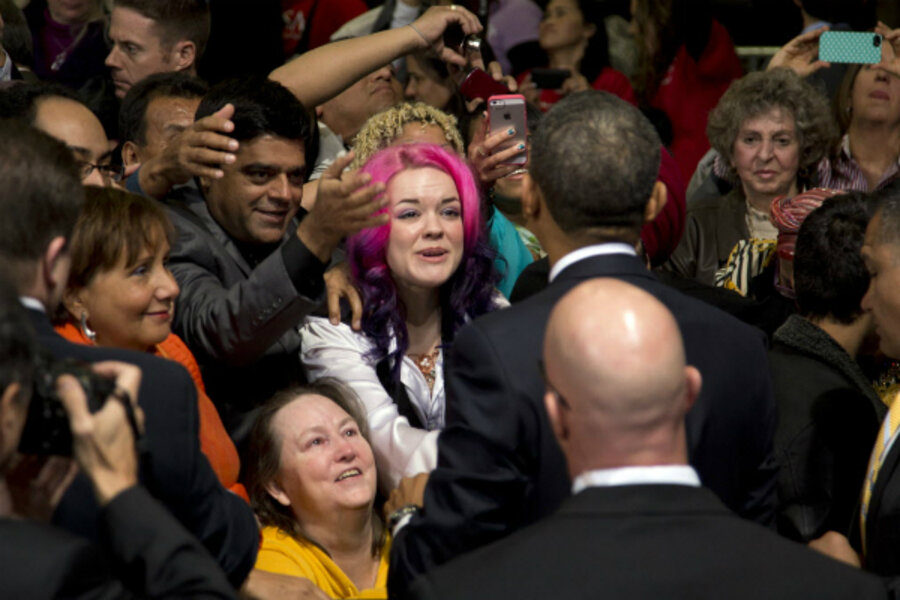Immigration reform: a bid to attract workers who will boost the economy
Loading...
As a bipartisan group of US senators and President Obama lead a push to enact sweeping immigration reform this year, they are boosting the idea with a rationale that is economic as well as social.
Reform isn’t just about reuniting families, better securing the border, or dealing pragmatically with immigrants who have been in the country for years but lack legal status, they say. It’s also, importantly, about helping the US economy continue to prosper in the years ahead.
It’s an argument that many economists support.
In fact, some policy experts say that welcoming more immigrants with advanced degrees ranks high on the list of ways to boost long-term job creation.
"Improving the system regulating high-skilled immigration needs to be a key focus of any immigration reform bill," economist Robert Atkinson said Tuesday, in a statement released by the research group he heads, the Information Technology and Innovation Foundation (ITIF) in Washington. "We cannot continue to fall behind other nations in attracting the highly skilled individuals to our shores.”
Separately from the broad immigration-reform proposals, a bipartisan group of senators led by Orrin Hatch (R) of Utah and Amy Klobuchar (D) of Minnesota introduced an Immigration Innovation Act of 2013 bill Tuesday, designed to boost the number of high-skill foreign workers.
This bill seeks to grant green cards to more holders of advanced science and engineering degrees. It would also nearly double the limit on so-called H-1B visas, allowing some 115,000 foreigners to hold jobs at US high-tech firms – a cap that would adjust up or down based on economic conditions. Critics of the H-1B program see it as a gift of lower-wage labor to private industry, and say US workers could do those jobs.
Neither Mr. Obama nor the so-called “gang of eight” senators has crafted a detailed legislative proposal for more comprehensive reform. But both call for extending an immigration welcome mat to more highly trained people from other nations.
“Intel was started with the help of an immigrant who studied here and then stayed here,” the president told an audience in at Del Sol High School in Las Vegas on Tuesday. “Instagram was started with the help of an immigrant who studied here and then stayed here. Right now, in one of those classrooms, there’s a student wrestling with how to turn their big idea, their Intel or Instagram, into a big business.”
He added that failing to let many of them stay in America after they graduate is “not how you grow new industries in America.”
Obama called for comprehensive immigration reform with three core parts: strengthening borders, creating a path toward green cards and possible citizenship for 11 million immigrants now in the US illegally, and bringing the system of legal immigration – including for high-skill applicants – “into the 21st century.”
The president’s blueprint aligns in some important ways with the framework unveiled by the bipartisan group of senators, including Sens. Charles Schumer (D) of New York and John McCain (R) of Arizona.
The second of four parts in their plan is “attracting the world’s best and brightest” by overhauling the system for legal immigration. “Our immigration proposal will award a green card to immigrants who have received a PhD or Master’s degree in science, technology, engineering, or math from an American university,” their framework says.
Although embraced by many economists, this idea remains controversial in the public eye – as are many facets of immigration reform. Granting access to trained foreign workers may appear to be a direct threat to US workers, at a time when legions of native-born college grads are having trouble finding jobs in their fields of study.
The jobs recovery since the recession of 2007 to 2009 has been faster for immigrants than for native-born workers, the Pew Research Hispanic Center found last year. The center said the pace of immigrant job growth was in line with the growth in the group’s working-age populations.
But the argument in favor of a welcoming stance, voiced by Obama, is that immigrants historically have made a large contribution to entrepreneurial job creation. He said that in recent years 1 in 4 new high-tech firms and small businesses have been founded by immigrants.
The message: More green cards and citizenship approvals should translate into more jobs.
Obama added that labor leaders, as well as business groups, are rallying behind the idea of immigration reform.
More broadly, many economists argue that it’s inaccurate to view immigrants as taking jobs from native-born workers. The newcomers are a supply of new labor, but they also bring demand for new goods and services.
A 2009 United Nations report, for example, argued that “migrants boost economic output, at little or no cost to locals.”








